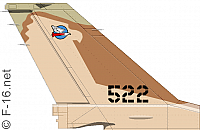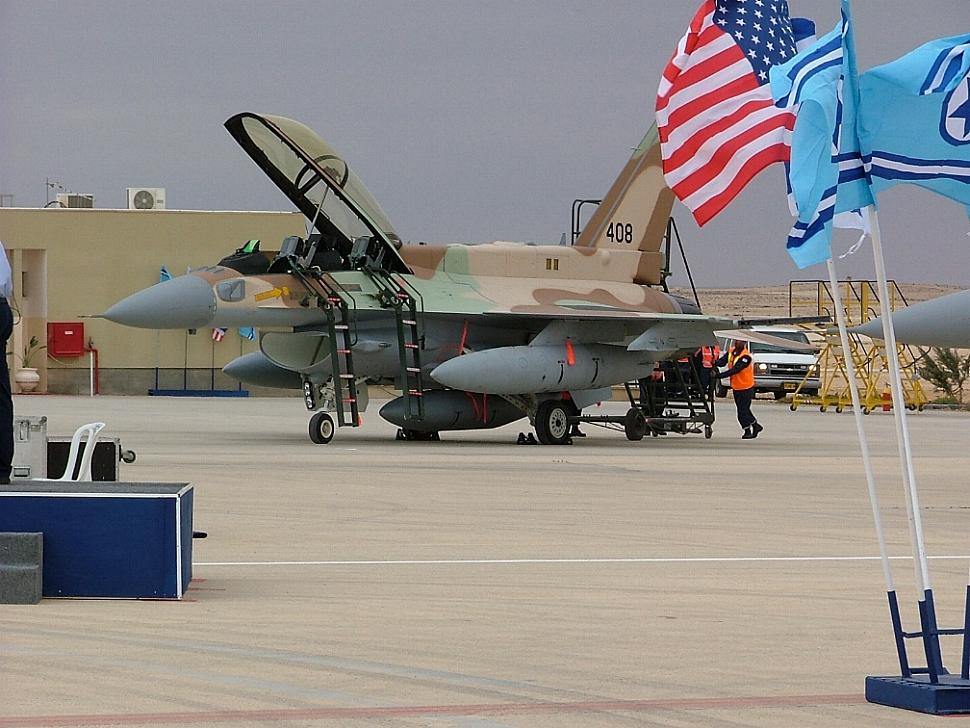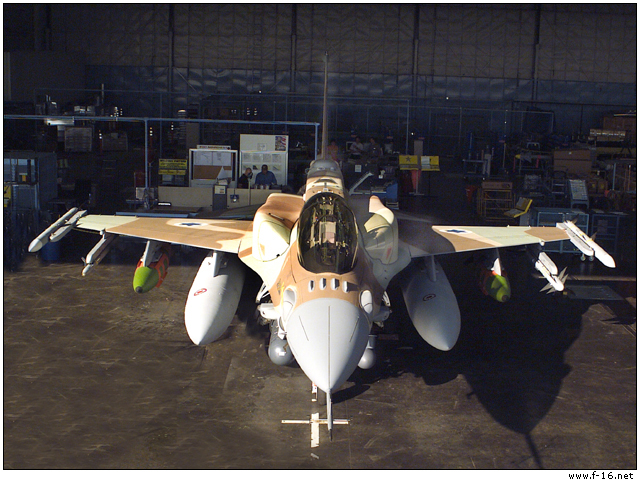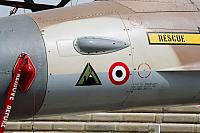Introduction
The Israel Defense Force/Air Force ordered a total of 362 F-16s, from early F-16A/Bs to the latest F-16I. Fifty of these aircraft were surplus USAF aircraft, given to Israel by the US as payment for restraint during the 1991 Gulf War despite Scud attacks. All Israeli F-16s are fitted with custom Israeli electronics.
Israeli F-16s have been used extensively in combat, and scored 47 kills to date. They were also used in the bombing of the Iraq's nuclear reactor in Osirak.
History
The Israel Defense Forces/Air Force (IDFAF) got its first chance to test the Fighting Falcon with the 388 TFW at Hill AFB, which was the first USAF unit operational on type. The IAF test pilot team recommended the purchase of the airplane. Referring to the decisions leading to the acquisition of the F-16s, former IDFAF commander Brigadier David Ivri explains: "The decision to buy the General Dynamics F-16, resulted mostly from the very high price of the McDonnell-Douglas F-15 Eagles". At the F-16 hand-over ceremony (which was held on January 31st, 1980, right after the Iranian F-16 deal was cancelled because of the fall of the Shah), Ivri explained: "After all quantity counts, and it is a major factor in the chances to win, ...so we chose a solution combining quantity and quality".
Inventory
Peace Marble I
In August of 1978, when the Carter Administration's arms sales restrictions policy had reached its zenith, the government of Israel announced plans to acquire 75 F-16A/B's. The fact that Israel had just signed the Camp David agreements with Egypt, however, had established an Israel-friendly climate in Washington, and the acquisition plans were approved.
The first F-16 deliveries to Israel (all 75 block 10 aircraft, except for 18 F-16A's and 8 B's that were originally built as block 5 but had already been converted to Block 10) took place under the Peace Marble I Foreign Military Sales program. These planes were originally intended for the Imperial Iranian Air Force, but the demise of the Shah in 1979 and the consequent rise of the Islamic fundamentalist regime caused these planes to be diverted to Israel. They had a number of internal changes that were unique to Israeli requirements, including the fitting of chaff/flare dispensers. The first IDFAF F-16, together with some other Vipers, was flown to Hill AFB, where initial pilot and ground crew conversion took place.
The first four F-16s, known as Netz (Hawk) in IDFAF service and wearing standard sand/brown/green camouflage colors, arrived in Israel in July of 1980 after an 11 hour delivery flight. IOC was achieved a few weeks later. Although the last 22 of these aircraft were put on hold by the Reagan Administration following the Raid on the Osirak reactor, final deliveries took place in 1981.
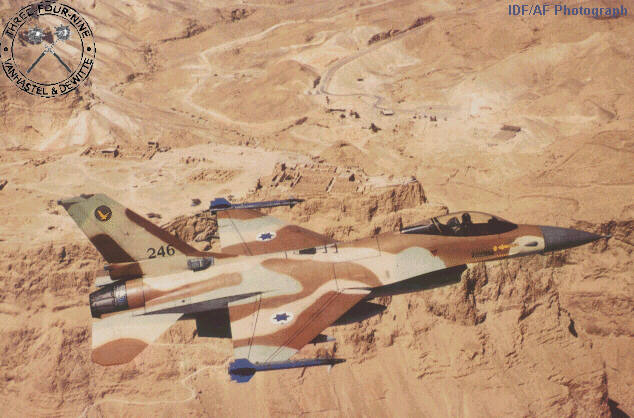
Peace Marble II
Under Peace Marble II, the Tsvah Haganah le Israel / Cheil Ha'avir (Israel Defense Force/Air Force) was supplied with late-model F-16C/D's (block 30), the first F-16C of which arrived in October 1987. The first F-16D was received by the IAF on December 21, 1987, and was seen in 'First Combat squadron' colors, carrying the tail number #031. A total of 75 Block 30 aircraft was delivered: 51 F-16C's and 24 F-16D's (locally known as Barak or Lightning) and 24 F-16D's.
Peace Marble III
Following the cancellation of the indigenous Lavi fighter project in May of 1988, a follow-on order was placed for 60 F-16C/D block 40 aircraft (30 F-16C's, 30 F-16D's), plus an option for 15 more. This was under Peace Marble III. The first of these Fighting Falcons, all nicknamed 'Barak II', arrived in Israel in August of 1991.
Peace Marble IV
As payment for restraint during the 1991 Gulf War, Israel was provided with 50 surplus USAF F-16A/B's, all Block 10 aircraft. Contrary to earlier deliveries, these aircraft retained their USAF air superiority gray color scheme at that time. The aircraft are called Netz II locally. The first of these (ex- 'DO' 907th FG and 'MI' 127th FW aircraft) were delivered on August 1st, 1994 under the Peace Marble IV program. The delivery was completed in late 1994.
About half of these aircraft were ex-ANG/AFRes aircraft, with the remainder being brought out of storage at Davis-Monthan AFB. The largest batch delivered to Israel were 12 F-16A/B's from the 157th Fighter Interceptor Squadron from the South Carolina ANG. These F-16A/B's will be used primarily for training, but will undergo a number of modifications prior to entering IDFAF service. Further purchases of F-16s by Israel appear likely, probably block 50 aircraft that are LANTIRN-capable. Some of these might be built under license in Israel by IAI.
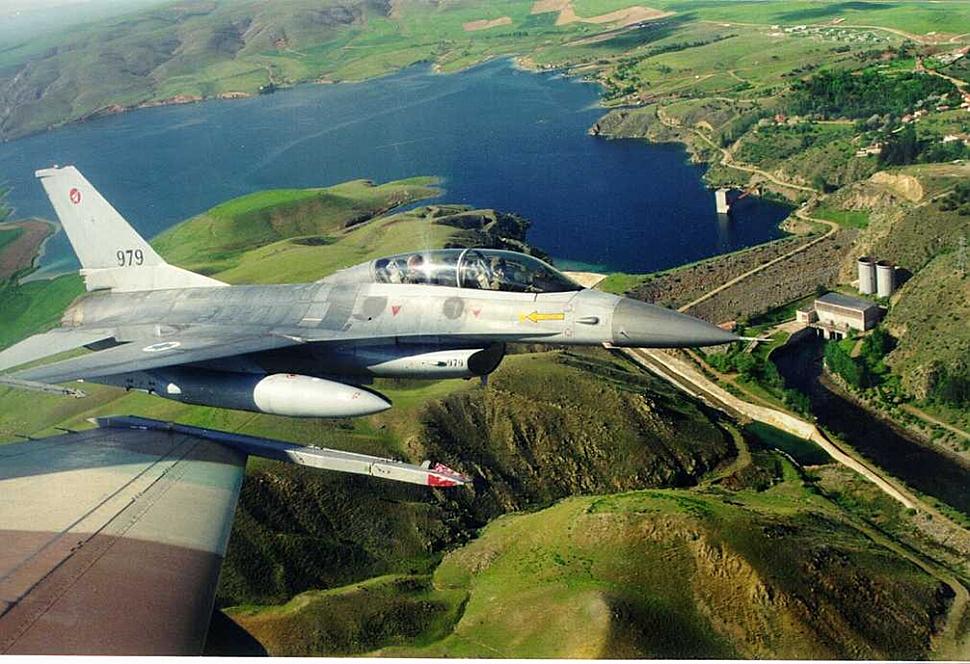
Peace Marble V
On July 1st, 1997, Ilan Biran, director-general of Israel's Ministry of Defense, declared Israel intends to purchase a new batch of US fighters (either F-16s or more F-15I's) in early 1998, with deliveries shortly after 2000. The acquisition would proceed under a buy-now, pay-later scheme that essentially will drain Israel's annual $1.8 billion US aid account through 2005 or 2006. 3 days later, the IDFAF commander Maj. Gen. Eitan Ben-Eliahu declared the IDFAF has a need for 50 to 100 new fighters during the next seven or eight years to replace A-4, F-4 and older F-16 fighters. Range and quantity are the top two priorities in the estimated $3 billion fighter competition. The latest rumors at that time suggested that Israel planned to buy a supposed number of 30 new F-16, probably block 60's with partially-Israeli avionics. Around the same time, F-4E's (that were not upgraded), would phase out from service. The rest of the order would consist of F-15I's then, but if a 2nd batch of F-15I's would prove to be too expensive, then the obvious alternative would be to buy improved F-16D's.
On September 22nd, 1998, the US Government proposed two alternatives to Israel: either 30 F-15I or 60 F-16C/D aircraft could be acquired. Total value of either deal would be around USD $2.5 billion. In case the IDFAF cannot make up its mind, the US also proposed a mix of the two types. The aircraft will replace the remaining Sky Hawks and Phantoms in service, as well as some of the oldest F-16s. Both F-15I's and F-16C/D's would be equipped with LANTIRN pods and AIM-120 AMRAAM. A final decision was expected end 1998 or beginning 1999, but was repeatedly postponed.
In February 1999, however, Israel raised the stakes in its tender for fighter planes, telling Lockheed Martin Ltd. and Boeing Co it would spend up to $4 billion on the order expected by May, which translates roughly into 110 F-16s. Some air force officials speculated then that Israel would ultimately split the contract, buying some planes from Boeing and some from Lockheed. Aircraft industry sources said Israel's Defense Ministry had made a similar request for prices from Boeing. Both companies will issue their final offers in April. Israel's Defense Ministry said it expected to award the contract in May of 1999.
Lockheed, which lost the last Israeli aircraft tender to Boeing in 1994, said its single-engine F-16 aircraft could now fly as far as the twin-engine F-15I offered by Boeing. Lockheed has developed attachable fuel tanks that increased the range of the F-16s radius of operations to 1,500 km (800 miles). Israeli pilots tested the F-16 in the United States in 1999 fitted with the new fuel tanks.
Israel chose the F-15I five years ago over the cheaper Lockheed model to counter perceived threats from Iran, which is developing long-range missiles and -- Israel says -- non-conventional warheads.
At the end of the tender, on January 14th, 2000, the Israeli government decided to buy 50 F-16D block 52, with an option of 60 more, in a purchase worth approximately $2.5 billion. The option, reduced to 52 planes, was exercised on September 4th, 2001, bringing the total to 102 F-16D Block 52's, worth an astonishing $4.5 billion.
On November 14th, 2003, the first (actually the fourth) F-16I (#253) was presented in a roll-out ceremony at LMTAS' Fort Worth facility. On February 19th, 2004, the first two F-16Is (#407 and #408) landed at the Mizpe Ramon Israel Air Force base in the Negev, after a ferry flight from Forth Worth via the Azores.
| Program | Model | Block | Qty. | Serials | Delivered |
|---|---|---|---|---|---|
| Peace Marble I | F-16A | Block 5 | 18 | 100/138 (Random nrs) | 1980-1981 |
| F-16B | Block 5 | 8 | 001/017 (Random nrs) | 1980-1981 | |
| F-16A | Block 10 | 49 | 219/299 (Random nrs) | 1980-1981 | |
| Peace Marble II | F-16C | Block 30 | 51 | 301/398 (Random nrs) | 1986-1987 |
| F-16D | Block 30 | 24 | 020/088 (Random nrs) | 1987-1988 | |
| Peace Marble III | F-16C | Block 40 | 30 | 502/558 (Random nrs) | 1991-1993 |
| F-16D | Block 40 | 30 | 601/687 (Random nrs) | 1991-1993 | |
| Peace Marble IV | F-16A | block 1 | 3 | 700/799 (Random nrs) | 1994 |
| F-16B | Block 1 | 2 | 900/999 (Random nrs) | 1994 | |
| F-16A | Block 5 | 1 | 700/799 (Random nrs) | 1994 | |
| F-16B | Block 5 | 7 | 900/999 (Random nrs) | 1994 | |
| F-16A | Block 10 | 32 | 700/799 (Random nrs) | 1994 | |
| F-16B | Block 10 | 5 | 900/999 (Random nrs) | 1994 | |
| Peace Marble V | F-16D | Block 52 | 102 | 400/499 & 800/899 (Random nrs) | 2003-2009 |
Modifications & Armament
F-16A/B Netz
Seventeen technical modifications, designed by the IAF and Israeli military industries, were made to the Israeli F-16A/B's. Most of them in the software and in the mission computers, which enabled the F-16 to operate the unique weapon systems. Fin-root fairings on early F-16A's house the Rapport system.
In 1992 all IAF F-16A/B's (excluding the latest batch of Netz 2 aircraft) went into an upgrade phase at Israeli Aircraft Industries (IAI), where wings were structurally reinforced, and Elbit's advanced flight and mission management system was installed. By the end of this phase, all F-16A/B's were system equaled with the F-16C's; however, the engine remained the original F-100.
F-16C/D Barak
Externally, the Israeli F-16C differs from other F-16C's by having an extension to the base of its vertical stabilizer, similar to the Norwegian F-16s parachute brake compartment; however, no parachutes are used on IAF F-16s. Israeli F-16s have extensive local modifications, with different avionics fits and higher gross weights, requiring changes in the landing gear and the use of new wheels. The maximum all-up weight of an Israeli F-16 is 48,000 pounds, as compared to 42,300 pounds for a USAF Block 40 F-16C. The third batch of F-16C/D's is fitted with Elta's EL/L-8240 ECM, replacing Lockheed Martin Defense Systems' (LMDS, formerly Loral) AN/ALQ-178 Rapport III internal ECM. F-16C's appear to have larger navigation lights mountings on the intake. These most likely house electronics. The F-16C/D's ordered to compensate for the cancelled Lavi Project received Israeli ECM systems (manufactured by Elisra), and flight management computers (made by Elbit).
While the F-16B is a two seat version of the F-16A used for pilot conversion, the Israeli F-16D is completely different from the F-16C. The back seat is reserved for the F-16s Weapon System Operator, just as one can find at the F-4 Phantom. Externally, this fighter differs from other F-16D's by having a boxlike extension from the cockpit to the vertical stabilizer, referred to as a dorsal spine.
The dorsal fairing was designed, mocked up, fabricated and installed during regular routine assembly while these aircraft were on the production line in Fort Worth. At no time has IAI had anything to do with initial design, fabrication of assemblies or production installation of any dorsal assemblies. The dorsal spine is believed to accommodate Wild Weasel equipment (amongst others Elisra's SPS-3000 self-protection jammer) which detects emissions from enemy radar sites and pinpoints their locations, and specialized weapon delivery systems, such as 'smart bombs' guided using the back seat's side stick for control. The IDFAF would confirm only that this space is filled with various electronic systems.
According to the IDFAF Magazine, this version of the F-16D is much heavier than the 'standard' production F-16D's. Its empty weight is 9,525 kg, while the standard version weighs just 7,900 kg. The maximum takeoff weight was extended to 21,770 kg - 4,760 kg more than the standard version, a fact made possible by modifications made to the landing gear. The extent of the modifications called for a different (non-official) model designation, hence the Israeli F-16D was designated IF-16D. As the F-16C's in service by the IDFAF, the IF-16D is powered by a General Electric F110-GE-100 engine, with an enlarged air intake.
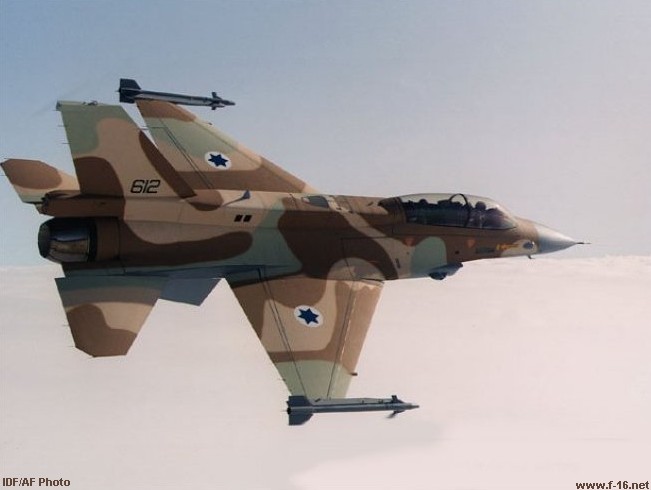
F-16I Sufa
The F-16I looks radically different from other F-16s, with Conformal Fuel Tanks, dorsal spine, and numerous fairings and bulges for undisclosed equipment. Rumor has it that a lot of the equipment is only installed after delivery to Israel.
CK-1 Testbed
The IDFAF operates a 'customized' F-16D Block 40 test bed aircraft, designated CK-1.
Targeting and Navigation pods
IDF/AF F-16C/D Fighting Falcons were originally fitted with the Martin-Marietta Sharpshooter pod, which is a downgraded version of the Martin Marietta AN/AAQ-14 LANTIRN targeting pod. The Sharpshooter pods were later replaced by the Rafael Litening infrared targeting and navigational pod, and the Sharpshooter pods were transferred to the F-15I Eagles. During the roll-out ceremony, the F-16I carried both Lantirn pods.
Armament
In May 1989, the IDFAF revealed an F-16D at Hatsor AFB carrying a AGM-78D 'Standard ARM' missile which was used to attack Syrian SA batteries during the Peace of Galilee operation in Lebanon, confirming the suspicion that F-16Ds were used in a Wild Weasel role.
Israeli F-16s operate with a variety of locally-developed weapons, including the advanced Python 4 & 5 air-to-air missiles and the Popeye & Spice AGM's.
The latest batch of IDFAF F-16D Block 52 will be equipped to carry a wide range of modern weapons, including domestically developed ECM equipment. All of the planes will be in a dual-seat configuration with a Weapon Systems Officer in the backseat to operate all of the electronics.
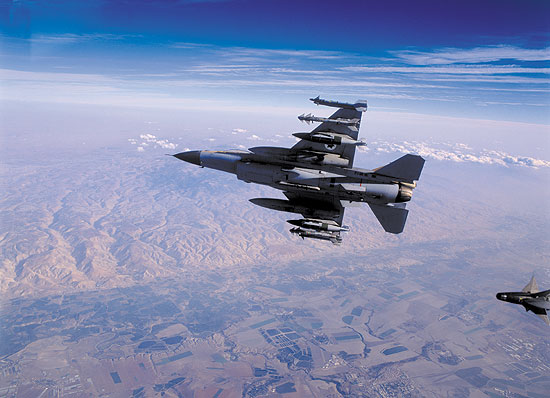
Operational Service
Units
Please refer to the F-16 Units section for an overview of units.Deployments
|
Combat Of 67 kills achieved by the F-16 world-wide, 47 are accredited to the IDFAF's F-16s. Combat debut of the F-16 was on April 28th, 1981, when an IDFAF F-16 of the 'First Jet Squadron' shot down a Syrian Mi-8 helicopter over Riak, near the Lebanese town of Zahle. Five hours later, another Syrian Mi-8 fell prey to another F-16 of the same squadron. On June 7th, 1981, Operation Opera put an abrupt - although probably temporary - end to Saddam Hussein's nuclear weapons program, when eight IDFAF F-16A's destroyed Iraq's Osirak (Tamuz) nuclear reactor near Baghdad, involving a 1000-mile round-trip journey - well over the official range of the F-16. The bombs used were conventional high-explosive bombs rather than laser-guided bombs because of the high accuracy of the F-16s bombing computer. Since the American government had not been consulted in advance about the Osirak attack, the Reagan administration publicly denounced the raid as militarily reckless and temporarily held up a final batch of 22 F-16A/B's to Israel. However, the embargo was lifted in August of 1981 and deliveries of F-16s to Israel were allowed to continue. The first fighter kill of the F-16 in the world, took place at July 14th, 1981, when Lieutenant-Colonel Amir Nachumi, the squadron's leader (leader of the second formation during 'Operation Opera'), downed a Syrian MiG-21. During 1982, the period before the Lebanon war, 3 Syrian MiG-21s and 2 Syrian MiG-23s were shot down. In 1983-84, F-16s played a key role in Operation Drugstore-Artzav 19, an attack on Syrian missile sites in the Bekaa Valley in Lebanon. Numerous missile sites were attacked and destroyed and fierce air battles with Syrian fighters took place. A total of 92 Syrian fighter (more than 30% of total inventory) were shot down, and Israeli F-16s achieved a 44-0 kill ratio. One aircraft reportedly shot down four Syrian fighters in a single sortie. There is at least one IDFAF F-16 with four Syrian kill-markings on its fuselage. First combat activity of the F-16C's in the IDFAF took place on April 22nd, 1988, when according to IDF spokesman: "Friday afternoon, IDFAF airplanes attacked terrorist bases south of Beirut. Targets were terrorist command centers, ammunition depots and weapon systems. Accurate hits were achieved." During an interview given to the IDFAF Magazine, the squadron leader, Lieutenant-Colonel Y., described the airplane: "Compared to any other fighter I know, the 'Barak' maintains a very good operational profile, even, as usually is the case, it is flown in a 'dirty' aerodynamically configuration. This fighter is a true breakthrough in power/weight ratio, that allows the airplane to achieve high penetration speeds while keeping high maneuverability. This fighter could penetrate at low altitudes at speeds exceeding 500 knots (927 km/h) with external loads, while other fighters would not achieve greater speeds than 450 knots (834 km/h), and this has a significant meaning for the fighters survivability and ability to carry out the mission". The First Jet squadron carries out daily interception alerts, air patrols, training for air to air and air to ground missions. The squadron leader also revealed, that the squadron carried out two 'serious' missions. One of them was a direct attack with iron bombs. This attack turned out to be so accurate, pilots said it might be the end of the era of the 'smart' bombs. The other mission was an attack carried out at night, when accurate hits were achieved using a radar assisted attack mode, while no night vision aids were used. Lieutenant-Colonel Y. concluded his assessment of the F-16C fighter by saying: "Take the flying characteristics, its accurate bombing and interception ability, add to it a unique self defense system to give it exceptional survivability in the combat zone, and you've got a nearly perfect fighter!" |
Special thanks
- Tsahi Ben-Ami;
- Zvi Kreisler.
Please use this form to add any list any error or omissions you find in the above text.
Note: your comments will be displayed immediately on this page. If you wish to send a private comment to the webmasters, please use the Contact Us link.

